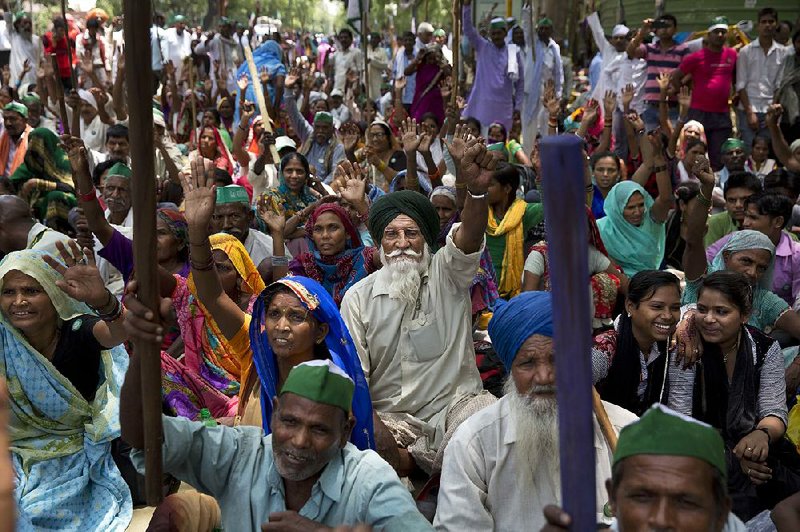As monsoon rains move across India -- usually a boom time for the agriculture sector -- farmers have left their land and taken to the streets as their anger grows over falling food prices and high debts.
With protests spreading across the country, the government of Prime Minister Narendra Modi is under pressure to provide more incentives. A drop in food prices spurred deadly clashes last week, while India's food inflation fell into negative territory, dropping 1.05 percent from a 0.61 percent rise in April, data showed Monday.
Farmers are a powerful voting bloc, and the government already faces criticism for not making significant progress toward its promise of doubling farmers' income by 2022 and ensuring a 50 percent profit over the cost of crop production.
"There will be tremendous pressure on the Modi government from farmers and young people looking for employment," said political scientist and pro-vice chancellor of Bengaluru's Jain University, Sandeep Shastri. "These are the two biggest challenges the government will face in the coming years -- in both these areas very little has been done in concrete terms."
About two-thirds of the country's agricultural debt of about $147 billion is in states where a debt waiver has been announced or promised or in states that will go to the polls in the next two years, Nomura Holdings Inc. analysts Adarsh Parasrampuria and Amit Nanavati said in a Tuesday note. "Increasing expectation of a debt waiver could possibly lead to worsening of debt servicing in states where [a] debt waiver package has not been announced."
Finance Minister Arun Jaitley said Monday that states will have to generate their own resources for the loan waiver.
Keeping a key election promise, the newly formed state government in Uttar Pradesh decided to waive farm loans worth $5.6 billion for more than 21.5 million farmers at its first Cabinet meeting in April.
After the Uttar Pradesh announcement, Maharashtra on Sunday decided to waive crop loans worth about $4.6 billion taken by small and medium farmers.
Farmers in Uttar Pradesh and Haryana protested while others in Madhya Pradesh continued to demand loan waivers and higher crop prices. Demonstrators last week blocked roads and vandalized property in the state ruled by Modi's Bharatiya Janata Party after five farmers were killed when police fired on protesters.
"The whole question of loan waiver and higher prices are soft measures. What is needed is a very clear, comprehensive policy which addresses the long-term concerns of the viability of agriculture," Shastri said. "States will be also under pressure to waive loans," especially in those states where elections are scheduled in the next two years, Shastri added.
While high levels of household debts have been recognized as a significant cause of farmers' distress, the use of unconditional debt relief is contentious. India's central bank governor, Urjit Patel, called for governments to reject loan bailout programs, saying in April that "waivers engender moral hazard." About 800 million of India's 1.3 billion people count on agriculture for a living, while 52 percent of farming households are indebted.
If Tamil Nadu, Uttar Pradesh, Karnataka, Maharashtra, Rajasthan, Punjab, Maharashtra and Haryana were to waive agriculture loans, it would amount to as much as $35 billion or 1.3 percent of GDP, Credit Suisse analysts said in a Wednesday note.
Farmers from across the country joined the protest Thursday in Delhi to demand a federal investigation into last week's shootings, said Rakesh Tikait, a senior leader of Bharatiya Kisan Union. They also demanded higher crop prices, loan waivers and a ban on the import of farm produce, he said.
"Whichever government comes to power, they play with the sentiments of farmers and conspire to get our votes," said Mangeram Panwar, a farmer from Uttar Pradesh who attended the protest. "But after that they don't do anything for us. It's very difficult to live on farming."
Bumper harvests helped by normal rain last year after back-to-back droughts pushed down prices of some crops including oilseeds and legume seeds. The farmers protested those conditions as well as the lack of government-assured purchases.
Small landholdings and uncertain monsoonal rain make India one of the world's most expensive places to farm, while the country's rural economy provides few other job opportunities. Rising costs of fertilizers and seeds, along with the lack of an assured market for farmers' produce, add to their burden.
Business on 06/16/2017

